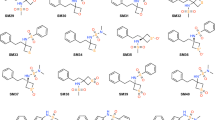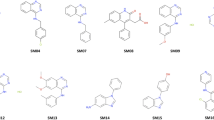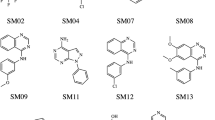Abstract
All-atom molecular dynamics simulations with stratified alchemical free energy calculations were used to predict the octanol-water partition coefficient \(\log P_{ow}\) of eleven small molecules as part of the SAMPL6-\(\log P\) blind prediction challenge using four different force field parametrizations: standard OPLS-AA with transferable charges, OPLS-AA with non-transferable CM1A charges, AMBER/GAFF, and CHARMM/CGenFF. Octanol parameters for OPLS-AA, GAFF and CHARMM were validated by comparing the density as a function of temperature, the chemical potential, and the hydration free energy to experimental values. The partition coefficients were calculated from the solvation free energy for the compounds in water and pure (“dry”) octanol or “wet” octanol with 27 mol% water dissolved. Absolute solvation free energies were computed by thermodynamic integration (TI) and the multistate Bennett acceptance ratio with uncorrelated samples from data generated by an established protocol using 5-ns windowed alchemical free energy perturbation (FEP) calculations with the Gromacs molecular dynamics package. Equilibration of sets of FEP simulations was quantified by a new measure of convergence based on the analysis of forward and time-reversed trajectories. The accuracy of the \(\log P_{ow}\) predictions was assessed by descriptive statistical measures such as the root mean square error (RMSE) of the data set compared to the experimental values. Discarding the first 1 ns of each 5-ns window as an equilibration phase had a large effect on the GAFF data, where it improved the RMSE by up to 0.8 log units, while the effect for other data sets was smaller or marginally worsened the agreement. Overall, CGenFF gave the best prediction with RMSE 1.2 log units, although for only eight molecules because the current CGenFF workflow for Gromacs does not generate files for certain halogen-containing compounds. Over all eleven compounds, GAFF gave an RMSE of 1.5. The effect of using a mixed water/octanol solvent slightly decreased the accuracy for CGenFF and GAFF and slightly increased it for OPLS-AA. The GAFF and OPLS-AA results displayed a systematic error where molecules were too hydrophobic whereas CGenFF appeared to be more balanced, at least on this small data set.









Similar content being viewed by others
References
Kramer W (2011) Transporters, Trojan horses and therapeutics: suitability of bile acid and peptide transporters for drug delivery. Biol Chem 392(1–2):77–94. https://doi.org/10.1515/BC.2011.017
Leeson PD, Springthorpe B (2007) The influence of drug-like concepts on decision-making in medicinal chemistry. Nat Rev Drug Discov 6(11):881–90. https://doi.org/10.1038/nrd2445
Lipinski CA, Lombardo F, Dominy BW, Feeney PJ (1997) Experimental and computational approachesto estimate solubility and permeability in drug discovery and development settings. Adv Drug Deliv Rev 23(1):3–25. https://doi.org/10.1016/S0169-409X(96)00423-1
Bannan CC, Burley KH, Chiu M, Shirts MR, Gilson MK, Mobley DL (2016) Blind prediction of cyclohexane-water distribution coefficients from the SAMPL5 challenge. J Comput Aided Mol Des 30(11):927–944. https://doi.org/10.1007/s10822-016-9954-8
Işık M, Levorse D, Mobley DL, Rhodes T, Chodera JD (2020) Octanol-water partition coefficient measurements for the SAMPL6 blind prediction challenge. J Comput Aided Mol Des. https://doi.org/10.1007/s10822-019-00271-3
Beckstein O, Iorga BI (2012) Prediction of hydration free energies for aliphatic and aromatic chloro derivatives using molecular dynamics simulations with the OPLS-AA force field. J Comput Aided Mol Des 26(5):635–645. https://doi.org/10.1007/s10822-011-9527-9
Beckstein O, Fourrier A, Iorga BI (2014) Prediction of hydration free energies for the SAMPL4 diverse set of compounds using molecular dynamics simulations with the OPLS-AA force field. J Comput Aided Mol Des 28(3):265–276. https://doi.org/10.1007/s10822-014-9727-1
Kenney IM, Beckstein O, Iorga BI (2016) Prediction of cyclohexane-water distribution coefficients for the SAMPL5 data set using molecular dynamics simulations with the OPLS-AA force field. J Comput Aided Mol Des 30(11):1045–1058. https://doi.org/10.1007/s10822-016-9949-5
Selwa E, Kenney IM, Beckstein O, Iorga BI (2018) SAMPL6: calculation of macroscopic pKa values from ab initio quantum mechanical free energies. J Comput Aided Mol Des 32(10):1203–1216. https://doi.org/10.1007/s10822-018-0138-6
Işık M, Levorse D, Rustenburg AS, Ndukwe IE, Wang H, Wang X, Reibarkh M, Martin GE, Makarov AA, Mobley DL, Rhodes T, Chodera JD (2018) pKa measurements for the SAMPL6 prediction challenge for a set of kinase inhibitor-like fragments. J Comput Aided Mol Des 32(10):1117–1138. https://doi.org/10.1007/s10822-018-0168-0
Frisch MJ, Trucks GW, Schlegel HB, Scuseria GE, Robb MA, Cheeseman JR, Scalmani G, Barone V, Mennucci B, Petersson GA, Nakatsuji H, Caricato M, Li X, Hratchian HP, Izmaylov AF, Bloino J, Zheng G, Sonnenberg JL, Hada M, Ehara M, Toyota K, Fukuda R, Hasegawa J, Ishida M, Nakajima T, Honda Y, Kitao O, Nakai H, Vreven T, Montgomery JA Jr, Peralta JE, Ogliaro F, Bearpark M, Heyd JJ, Brothers E, Kudin KN, Staroverov VN, Kobayashi R, Normand J, Raghavachari K, Rendell A, Burant JC, Iyengar SS, Tomasi J, Cossi M, Rega N, Millam JM, Klene M, Knox JE, Cross JB, Bakken V, Adamo C, Jaramillo J, Gomperts R, Stratmann RE, Yazyev O, Austin AJ, Cammi R, Pomelli C, Ochterski JW, Martin RL, Morokuma K, Zakrzewski VG, Voth GA, Salvador P, Dannenberg JJ, Dapprich S, Daniels AD, Farkas O, Foresman JB, Ortiz JV, Cioslowski J, Fox DJ (2009) Gaussian 09 revision D.01. Gaussian Inc., Wallingford
Kaminski G, Duffy E, Matsui T, Jorgensen W (1994) Free energies of hydration and pure liquid properties of hydrocarbons from the OPLS all-atom model. J Phys Chem 98(49):13,077–13,082. https://doi.org/10.1021/j100100a043
Jorgensen WL, Maxwell DS, Tirado-Rives J (1996) Development and testing of the OPLS all-atom force field on conformational energetics and properties of organic liquids. J Am Chem Soc 118(45):11,225–11,236. https://doi.org/10.1021/ja9621760
Damm W, Frontera A, Tirado-Rives J, Jorgensen W (1997) OPLS all-atom force field for carbohydrates. J Comput Chem 18(16):1955–1970. https://doi.org/10.1002/(SICI)1096-987X(199712)18:16<1955::AID-JCC1>3.0.CO;2-L
Jorgensen WL, McDonald NA (1998) Development of an all-atom force field for heterocycles. Properties of liquid pyridine and diazenes. J Mol Struct Theochem 424(1–2):145–155. https://doi.org/10.1016/S0166-1280(97)00237-6
McDonald NA, Jorgensen WL (1998) Development of an all-atom force field for heterocycles. Properties of liquid pyrrole, furan, diazoles, and oxazoles. J Phys Chem B 102(41):8049–8059. https://doi.org/10.1021/jp981200o
Rizzo RC, Jorgensen WL (1999) OPLS all-atom model for amines: Resolution of the amine hydration problem. J Am Chem Soc 121(20):4827–4836. https://doi.org/10.1021/ja984106u
Kaminski GA, Friesner RA, Tirado-Rives J, Jorgensen WL (2001) Evaluation and reparametrization of the OPLS-AA force field for proteins via comparison with accurate quantum chemical calculations on peptides. J Phys Chem B 105(28):6474–6487. https://doi.org/10.1021/jp003919d
Dodda LS, Cabeza de Vaca I, Tirado-Rives J, Jorgensen WL (2017) LigParGen web server: an automatic OPLS-AA parameter generator for organic ligands. Nucleic Acids Res 45(W1):W331–W336. https://doi.org/10.1093/nar/gkx312
Vanommeslaeghe K, Hatcher E, Acharya C, Kundu S, Zhong S, Shim J, Darian E, Guvench O, Lopes P, Vorobyov I, Mackerell AD Jr (2010) CHARMM general force field: a force field for drug-like molecules compatible with the CHARMM all-atom additive biological force fields. J Comput Chem 31(4):671–90. https://doi.org/10.1002/jcc.21367
Vanommeslaeghe K, Raman EP, MacKerell AD (2012) Automation of the CHARMM General Force Field (CGenFF) II: assignment of bonded parameters and partial atomic charges. J Chem Inf Model 52(12):3155–3168. https://doi.org/10.1021/ci3003649
Vanommeslaeghe K, MacKerell AD (2012) Automation of the CHARMM General Force Field (CGenFF) I: bond perception and atom typing. J Chem Inf Model 52(12):3144–3154. https://doi.org/10.1021/ci300363c
Soteras Gutiérrez I, Lin FY, Vanommeslaeghe K, Lemkul JA, Armacost KA, Brooks CL, MacKerell AD (2016) Parametrization of halogen bonds in the CHARMM General Force Field: improved treatment of ligand–protein interactions. Bioorg Med Chem 24(20):4812–4825. https://doi.org/10.1016/j.bmc.2016.06.034
Wang J, Wolf RM, Caldwell JW, Kollman PA, Case DA (2004) Development and testing of a general AMBER force field. J Comput Chem 25(9):1157–74. https://doi.org/10.1002/jcc.20035
Sousa da Silva AW, Vranken WF (2012) ACPYPE: AnteChamber PYthon Parser interfacE. BMC Res Notes 5:367. https://doi.org/10.1186/1756-0500-5-367
Jorgensen WL, Chandrasekhar J, Madura JD, Impey RW, Klein ML (1983) Comparison of simple potential functions for simulating liquid water. J Chem Phys 79(2):926–935. https://doi.org/10.1063/1.445869
Huang J, MacKerell AD Jr (2013) CHARMM36 all-atom additive protein force field: validation based on comparison to NMR data. J Comput Chem 34(25):2135–45. https://doi.org/10.1002/jcc.23354
Maier JA, Martinez C, Kasavajhala K, Wickstrom L, Hauser KE, Simmerling C (2015) ff14SB: Improving the accuracy of protein side chain and backbone parameters from ff99SB. J Chem Theory Comput 11(8):3696–713. https://doi.org/10.1021/acs.jctc.5b00255
Price DJ, Brooks CL 3rd (2004) A modified TIP3P water potential for simulation with Ewald summation. J Chem Phys 121(20):10,096–10,103. https://doi.org/10.1063/1.1808117
Šegatin N, Klofutar C (2004) Thermodynamics of the solubility of water in 1-hexanol, 1-octanol, 1-decanol, and cyclohexanol. Chem Mon 135(3):241–248. https://doi.org/10.1007/s00706-003-0053-x
Lang BE (2012) Solubility of water in octan-1-ol from (275 to 369) K. J Chem Eng Data 57(8):2221–2226. https://doi.org/10.1021/je3001427
Cumming H, Rücker C (2017) Octanol-Water partition coefficient measurement by a simple 1H NMR method. ACS Omega 2(9):6244–6249. https://doi.org/10.1021/acsomega.7b01102
Abraham MJ, Murtola T, Schulz R, Páll S, Smith JC, Hess B, Lindahl E (2015) GROMACS: high performance molecular simulations through multi-level parallelism from laptops to supercomputers. SoftwareX 1–2:19–25. https://doi.org/10.1016/j.softx.2015.06.001
Shirts MR, Chodera JD (2008) Statistically optimal analysis of samples from multiple equilibrium states. J Chem Phys 129(12):124. https://doi.org/10.1063/1.2978177
Dotson D, Beckstein O, Wille D, Kenney I, Lee H, Lim V, Barhaghi MS (2019) alchemistry/alchemlyb: 0.3.0. Software. https://doi.org/10.5281/zenodo.3361016
Mobley DL, Dumont E, Chodera JD, Dill KA (2007) Comparison of charge models for fixed-charge force fields: small-molecule hydration free energies in explicit solvent. J Phys Chem B 111(9):2242–2254. https://doi.org/10.1021/jp0667442
Parrinello M, Rahman A (1981) Polymorphic transitions in single crystals: a new molecular dynamics method. J Appl Phys 52(12):7182–7190. https://doi.org/10.1063/1.328693
Shirts MR, Pitera JW, Swope WC, Pande VS (2003) Extremely precise free energy calculations of amino acid side chain analogs: comparison of common molecular mechanics force fields for proteins. J Chem Phys 119(11):5740–5761. https://doi.org/10.1063/1.1587119
Essman U, Perela L, Berkowitz ML, Darden T, Lee H, Pedersen LG (1995) A smooth particle mesh Ewald method. J Chem Phys 103:8577–8592. https://doi.org/10.1063/1.470117
Hess B (2008) P-LINCS: a parallel linear constraint solver for molecular simulation. J Chem Theory Comput 4(1):116–122. https://doi.org/10.1021/ct700200b
Hess B, Kutzner C, van der Spoel D, Lindahl E (2008) GROMACS 4: algorithms for highly efficient, load-balanced, and scalable molecular simulation. J Chem Theory Comput 4(3):435–447. https://doi.org/10.1021/ct700301q
Páll S, Abraham MJ, Kutzner C, Hess B, Lindahl E (2015) Tackling exascale software challenges in molecular dynamics simulations with GROMACS. In: Markidis S, Laure E (eds) Solving software challenges for Exascale: international conference on exascale applications and software, EASC 2014, Stockholm, Sweden, April 2–3, 2014, revised selected papers. Lecture notes in computer science, vol 8759, pp 3–27. Springer, Basel. https://doi.org/10.1007/978-3-319-15976-8_1
Klimovich PV, Shirts MR, Mobley DL (2015) Guidelines for the analysis of free energy calculations. J Comput Aided Mol Des 29(5):397–411. https://doi.org/10.1007/s10822-015-9840-9
Chodera JD (2016) A simple method for automated equilibration detection in molecular simulations. J Chem Theory Comput 12(4):1799–1805. https://doi.org/10.1021/acs.jctc.5b00784
Jorge M, Garrido N, Queimada A, Economou I, Macedo E (2010) Effect of the integration method on the accuracy and computational efficiency of free energy calculations using thermodynamic integration. J Chem Theory Comput 6(4):1018–1027. https://doi.org/10.1021/ct900661c
Virtanen P, Gommers R, Oliphant TE, Haberland M, Reddy T, Cournapeau D, Burovski E, Peterson P, Weckesser W, Bright J, van der Walt SJ, Brett M, Wilson J, Millman KJ, Mayorov N, Nelson ARJ, Jones E, Kern R, Larson E, Carey C, Polat I, Feng Y, Moore EW, VanderPlas J, Laxalde D, Perktold J, Cimrman R, Henriksen I, Quintero EA, Harris CR, Archibald AM, Ribeiro AH, Pedregosa F, van Mulbregt P, SciPy 1.0 Contributors (2019) Scipy 1.0—fundamental algorithms for scientific computing in Python. arXiv:1907.10121v1
Faber NKM (1999) Estimating the uncertainty in estimates of root mean square error of prediction: application to determining the size of an adequate test set in multivariate calibration. Chemom Intell Lab Syst 49(1):79–89. https://doi.org/10.1016/S0169-7439(99)00027-1
Zangi R (2018) Refinement of the OPLSAA force-field for liquid alcohols. ACS Omega 3(12):18089–18099. https://doi.org/10.1021/acsomega.8b03132
Işık M, Bergazin TD, Fox T, Rizzi A, Chodera JD, Mobley DL (2020) Assessing the accuracy of octanol-water partition coefficient predictions in the SAMPL6 Part II log P challenge. J Comput Aided Mol Des (in press)
Yang W, Bitetti-Putzer R, Karplus M (2004) Free energy simulations: Use of reverse cumulative averaging to determine the equilibrated region and the time required for convergence. J Chem Phys 120(6):2618–2628. https://doi.org/10.1063/1.1638996
Paranahewage SS, Gierhart CS, Fennell CJ (2016) Predicting water-to-cyclohexane partitioning of the SAMPL5 molecules using dielectric balancing of force fields. J Comput Aided Mol Des 30(11):1059–1065. https://doi.org/10.1007/s10822-016-9950-z
Brini E, Fennell CJ, Fernandez-Serra M, Hribar-Lee B, Lukšič M, Dill KA (2017) How water’s properties are encoded in its molecular structure and energies. Chem Rev 117(19):12,385–12,414. https://doi.org/10.1021/acs.chemrev.7b00259
Swope WC, Horn HW, Rice JE (2010) Accounting for polarization cost when using fixed charge force fields. II. Method and application for computing effect of polarization cost on free energy of hydration. J Phys Chem B 114(26):8631–8645. https://doi.org/10.1021/jp911701h
Lundborg M, Lindahl E (2015) Automatic gromacs topology generation and comparisons of force fields for solvation free energy calculations. J Phys Chem B 119(3):810–23. https://doi.org/10.1021/jp505332p
Acknowledgements
The authors would like to thank David L. Mobley and Teresa Danielle Bergazin for useful discussions and sharing unpublished data. Research reported in this publication was supported by the National Institute of General Medical Sciences of the National Institutes of Health under Awards Number R01GM118772 and R01GM125081. BII was supported in part by Grants ANR-10-LABX-33 (LabEx LERMIT) and ANR-14-JAMR-0002-03 (JPIAMR) from the French National Research Agency (ANR), and by a Grant DIM MAL-INF from the Région Ile-de-France
Author information
Authors and Affiliations
Corresponding author
Additional information
Publisher's Note
Springer Nature remains neutral with regard to jurisdictional claims in published maps and institutional affiliations.
Electronic supplementary material
Below is the link to the electronic supplementary material.
Rights and permissions
About this article
Cite this article
Fan, S., Iorga, B.I. & Beckstein, O. Prediction of octanol-water partition coefficients for the SAMPL6-\(\log P\) molecules using molecular dynamics simulations with OPLS-AA, AMBER and CHARMM force fields. J Comput Aided Mol Des 34, 543–560 (2020). https://doi.org/10.1007/s10822-019-00267-z
Received:
Accepted:
Published:
Issue Date:
DOI: https://doi.org/10.1007/s10822-019-00267-z




